Aileen Alpen, Foreign Correspondent
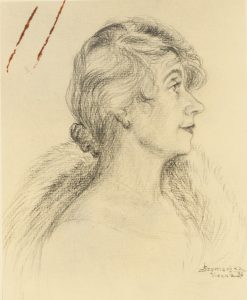
A sketch of Aileen Alpen, 1936. Courtesy State Library of NSW
Journalist, broadcaster, lecturer, teacher, interpreter, musician and linguist, Aileen Alpen was a trailblazer who forged her own path in Europe through two world wars. Born to German immigrant, Herr Hugo Alpen in Albury in 1873, she grew up one of his elder daughters in a large, musical, well-educated family. Composer, Herr Hugo Alpen was also a teacher, later becoming Superintendent of Music in Public Schools in NSW and settling at Mozart House, 57 Churchill Avenue, Strathfield. He regularly provided accompaniment to his talented daughters at concerts.
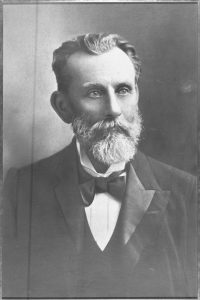
Herr Hugo Alpen. Courtesy National Library of Australia
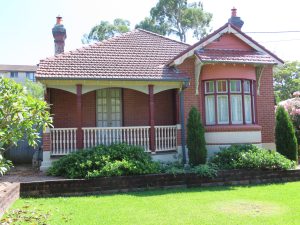
The former Mozart House, 57 Churchill Avenue, Strathfield, March 2023. Courtesy Strathfield Local Studies
Aileen was a confident and well-travelled young lady. A soprano, she often sang or gave recitations at fundraising and social events. She was educated at Sydney University and opened a small school in Tumut in 1895 where she taught piano, theory, singing, elocution, French, Latin, drawing, dancing and mathematics.
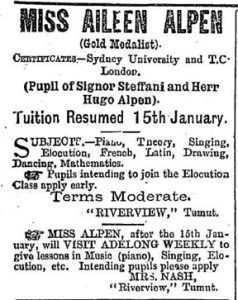
The Tumut and Adelong Times 19 January 1900
In 1907 Aileen’s younger brother, George travelled to Europe on a holiday but decided to settle in Brussels, Belgium where he opened a sports store. Perhaps his travels inspired Aileen and she set off for Europe to study music. In 1911 she was in London reporting firsthand on the coronation of King George V and Queen Mary from her seat in Pall Mall for the Freeman’s Journal.[1] Travelling to Italy, she spent several years there as a correspondent for Australian and English journals while studying. Her talent for languages and music, as well as her useful European contacts, opened many doors. Summer of 1912 saw her in Switzerland while autumn was spent pleasantly in Italy with the Marquis and Marquise Malenchini.[2] She also attended the Verdi Centenary Festival in Parma.[3] After visiting Paris she set sail for Sydney in late October 1913,[4] returning to Strathfield in January 1914 – but not for long.
The Great War had begun and the Alpen family feared for George’s safety in Europe. He had not been heard from since the outbreak of war. By October 1915 Aileen was back in London seeking news of her brother, missing – and considered an English spy – in Belgium.[5] Rumour reached home that he had been taken prisoner but George lived life on the run throughout the war years, working for the Resistance in Belgium, although the family appears to have had no news of him during this time. Herr Hugo died in 1917 but sadly, George only learned of this after war’s end. Meanwhile Aileen spent the remainder of the war in Italy as a freelance journalist, until censors intervened. Later, she claimed to have almost been shot during the war in Italy. And somewhere during her travels she met Mussolini.[6]
Aileen remained in Italy after the war. Here she met a Polish lady who invited her to Krakow to teach her children English which led to Aileen gaining a job lecturing at the university in English and Philosophy. Seeking further work as a journalist, Aileen sent articles to various newspapers in Sydney and a friend forwarded one to the Daily Advertiser (Wagga Wagga) who promptly appointed her their foreign correspondent. Later she also worked for two Polish newspapers.[7] By this time Aileen was fluent in five languages – English, French, Italian, German and Polish. At some point during these years she also taught English to a young Karol Wojtyla – the future Pope John Paul II, probably at the Jagiellonian University in Krakow.
Aileen returned home to visit Sydney in June 1929.[8] Not content with her careers in journalism, lecturing and broadcasting, she also sought to dabble in politics and trade. She hoped the Australian government would commission her to promote trade with Poland which she thought would benefit from importing Australian apples.[9] She also advocated for Polish immigration to Australia.[10]
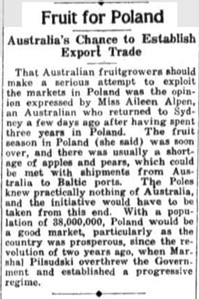
The Farmer and Settler 26 July 1929
During 1931 she wrote of her travels and the economic climate of Europe. She had just returned to Krakow from a holiday at Zakopane, a resort in the Tatry Mountains of Poland. That summer she also visited the Italian seaside resort of Viareggio, as the guest of the Marquise Gabriella Malenchini-Puccinelli, and Paris for the Colonial Exhibition – which she enjoyed immensely.[11]
Throughout the 1930s Aileen continued to write her column Europe Through Australian Eyes for the Daily Advertiser in Wagga Wagga. This consisted of a long, regular letter to readers on various European matters. Over the years she reported frankly – and with great insight – on all the political and economic matters of importance including the Depression, disarmament, appeasement, the growing aggression of Germany, Fascism and the Spanish Civil War. She commentated from her privileged position at the coalface and she was not afraid to tell it as she saw it.
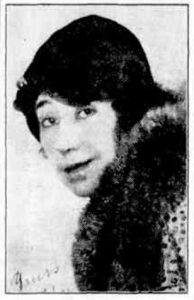
Aileen Alpen. The Daily Advertiser (Wagga Wagga) 7 August 1936 p.4
She also gave ‘propaganda’ talks broadcast on radio stations in a number of countries. In Poland she would educate listeners about Australia and during her visits home she would give talks about Poland. She arrived home for a visit to Australia on the Orama during July 1936.[12] These visits received great attention in the press as she travelled throughout NSW visiting her sisters and their families.
As early as November 1932 Aileen could see war looming in Europe:
‘We here can hear already the threatening rumble of approaching war, but Britain does not… We British have given enough of our blood, our splendid youth, in defending Belgium and France. Are we going again to wipe out another generation? Now can you see why I say that there can be no disarmament.’[13]
In the same letter she predicted war between America and Japan over the Pacific.
On 1 March 1933, Aileen wrote: ‘At the moment of writing Europe can only be compared to a box of gunpowder ready to explode at any minute, and it is feared that it will be Germany, under Nazi rule, that will light its match.’[14]
And more defiantly:
‘Herr Hitler’s strength is in his hold upon the people among whom he enjoys the same sort of popularity as a film star.’[15]
The Daily Advertiser in Wagga valued her sage opinions, writing of her in August 1933:
‘Her outlook is unbiased and she writes with the cold insight of the commentator who sees things as they are. The picture she presents in her letters is startingly clear and her prognostications have usually been borne out by subsequent events. The Europe she shows to us is a saddening and sombre one.’[16]
All too true. On 14 November Aileen wrote from Krakow to the editors of the Sydney Morning Herald and the Hebrew Standard of Australasia about the shocking plight of the 6000 Jewish refugees rounded up and sent over the Polish border at Zbaszyn after the pogrom of Kristallnacht,[17] or Night of Broken Glass, when Jewish shopkeepers’ windows were systemically smashed. She was there at the border to witness the horror herself.
‘You must understand that many of these people held good positions and without a chance to take clothes or, in some cases even to clothe themselves, were driven like animals and packed in the trains without warning either to them or the Polish government. When they protested they were beaten. Mothers have lost their children and children their brothers or sisters and husbands their wives, and they don’t know where to look for them, as the trains carrying them to Poland went to different frontiers. No defeat in war could cause Germany such shame as what they have done and are still doing to a people so weak and helpless. But the day of retribution will surely come.’[18]
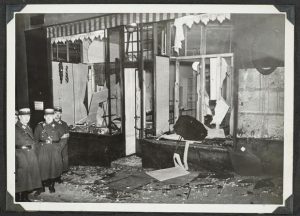
Nazis with smashed shop windows after Kristallnacht, November 1938. Courtesy Yad Vashem
By 1939 there was no turning back.
On 20 August 1939 Aileen wrote again knowing that war was imminent.
‘I think before you get this we will be at war. Poland, my Poland! She is brave, and in this time of stress she is calm and collected and ready for all. She will not yield an inch of what is hers and she is right. Her army is large and united and will fight to the last man. Viva Poland!’[19]
Aileen was broadcasting live on the air in Krakow as Poland was invaded on 1 September 1939 and could not return to her home. With instructions to round up and imprison all ‘British’ ex-pats in Poland, Aileen was in great danger. The Polish underground hid her for a month before, disguised as a peasant, she joined the refugees to Romania and then Paris, from there escaping to London.[20] From here she continued to report on the war for Australia. Twice her living quarters were bombed during the Blitz, including once when a piece of shrapnel passed through the (fortunately high) crown of her hat. Some months later she was able to meet with other English ladies who had been taken prisoner by the Germans in Krakow. Imprisoned for months in extremely harsh conditions, every one of them had been asked where Aileen Alpen was as her name was top of their list.
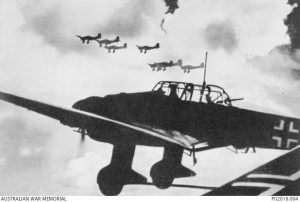
Stuka planes of the German Luftwaffe over Polish skies, September 1939. Courtesy Australian War Memorial.
Aileen spent Christmas 1940 in Holborn tube station with thousands of others, where she performed a kangaroo dance during the festivities to entertain the children. She attended mass each morning. After the church was bombed, and only the altar remained, she was the only worshipper the following morning along with the priest who bravely carried on with Mass amidst the ruins.[21]
Aileen’s brother George was again in trouble in Belgium. Having lived there now for 33 years, he and his Belgian wife, a highly-decorated Red Cross nurse, made their escape from Belgium. Eventually, after many further adventures, they made their way to Australia, where their son, Cecil Paul Alpen joined the AIF. George died in Sydney in 1943.
Aileen returned to Sydney during 1941. During the remainder of the 1940s she took several teaching positions in remote areas of NSW. According to the 1949 electoral rolls she was still teaching in Barraba, NSW, aged 76! But by 1950 she had retired to Kirribilli where she was interviewed by the Daily Telegraph about her brilliant career. She died in November 1955, aged 82, in Goulburn, where she was buried.
As post-war Australia welcomed thousands of displaced European immigrants, Aileen Alpen’s contribution should not be undervalued. More than 50,000 of these new Australians came from Poland between 1947 and 1954 to work as labourers.[22] No doubt many of them had heard Aileen broadcasting from Krakow before the war where she had raised the profile of Australia as a land of opportunity for hard working people looking for a new start.
Aileen’s was an inspiring life of international service in so many ways.
By J.J. MacRitchie
Local Studies Advisor
References
[1] Freeman’s Journal 27 July 1911 p.30 https://trove.nla.gov.au/newspaper/article/111093744[2] Sydney Morning Herald 27 November 1912 p. https://trove.nla.gov.au/newspaper/article/15378632
[3] Sydney Morning Herald 15 November 1913 p.4 https://trove.nla.gov.au/newspaper/article/15465913
[4] The Catholic Press 30 October 1913 p.22 https://trove.nla.gov.au/newspaper/article/107334474
[5] Sydney Morning Herald 16 October 1915 p.10 https://trove.nla.gov.au/newspaper/article/15619525
[6] The Sun 4 August 1929 p.7 https://trove.nla.gov.au/newspaper/article/222952773
[7] Daily Telegraph 2 July 1936 p.17 https://trove.nla.gov.au/newspaper/article/247054116
[8] Sydney Morning Herald 10 July 1929 p.20 https://trove.nla.gov.au/newspaper/article/16546710
[9] The Register News-Pictorial (Adelaide) 19 July 1929 p.37 https://trove.nla.gov.au/newspaper/article/53489674
[10] Dampier Herald (WA) 10 October 1929 p.3 https://trove.nla.gov.au/newspaper/article/256201729
[11] Freeman’s Journal 17 September 1931 p.16 https://trove.nla.gov.au/newspaper/article/118076469
[12] Sydney Morning Herald 2 July 1936 p.21 https://trove.nla.gov.au/newspaper/article/17247806
[13] Daily Advertiser (Wagga Wagga) 15 December 1932 p.2 https://trove.nla.gov.au/newspaper/article/143063053
[14] Daily Advertiser (Wagga Wagga) 8 April 1933 p.8 https://trove.nla.gov.au/newspaper/article/143146484
[15] Daily Advertiser (Wagga Wagga) 8 April 1933 p. 8 https://trove.nla.gov.au/newspaper/article/143146484
[16] Daily Advertiser (Wagga Wagga) 8 August 1933 p.2 https://trove.nla.gov.au/newspaper/article/143447920
[17] The Yivo Encyclopedia of Jews in Eastern Europe https://yivoencyclopedia.org/article.aspx/Zbaszyn
[18] Sydney Morning Herald 6 December 1938 p.11 http://nla.gov.au/nla.news-article17566302
[19] Daily Advertiser (Wagga Wagga) 6 September 1939 p.3 https://trove.nla.gov.au/newspaper/article/144239998
[20] Daily Telegraph 24 September 1950 p.13 https://trove.nla.gov.au/newspaper/article/248536812
[21] Goulburn Evening Post 13 February 1942 p.1 https://trove.nla.gov.au/newspaper/article/99786072
[22] Australian Government. Department of Home Affairs https://www.homeaffairs.gov.au/mca/files/2016-cis-poland.pdf
Further Reading
Albury Historical Society ‘Hugo Alpen – Albury’s First Mr Music’ https://alburyhistory.org.au/wp-content/uploads/2021/01/Hugo-Alpen.pdf
Jones, Cathy ‘Mozart House’ https://strathfieldheritage.com/streetnames/churchill-avenue-strathfield/mozart-house-57-albert-road-strathfield/
O’Rourke, Narelle ‘Sisters at Arms: Simonne Alpen, Edith Cavell & a Belgian/Australian Family at War’ Queanbeyan, NSW, 2015
